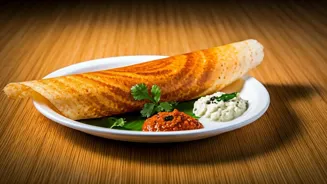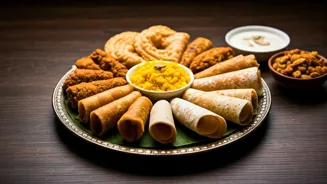Paratha: An Introduction
Paratha, a flatbread originating from the Indian subcontinent, holds a special place in the hearts and kitchens of many. It's a versatile dish, often enjoyed
for breakfast, lunch, or dinner. The beauty of a paratha lies in its simplicity and adaptability. It can be plain, filled with vegetables, or paired with a variety of accompaniments, making it a complete meal in itself. The term "paratha" is derived from the words "parat" and "atta," with "parat" meaning layers and "atta" referring to the flour, usually wheat flour, used in its making. The process typically involves kneading the dough, layering it with ghee or oil, and then cooking it on a hot griddle. Each bite offers a delightful combination of textures and flavors, ranging from soft and flaky to crispy and golden.
Plain Paratha: The Basics
The plain paratha is the foundational version, a testament to simplicity and taste. The key lies in the dough and the cooking process. Start with a mixture of whole wheat flour, salt, and water, kneading it until you achieve a soft, pliable dough. A crucial step is incorporating ghee or oil between the layers, which creates the characteristic flaky texture. This is often done by brushing the rolled-out dough with ghee, folding it, and then re-rolling it. The paratha is then cooked on a hot griddle, turning it frequently, until both sides are golden brown and slightly puffed up. Plain parathas are incredibly versatile and pair well with various dishes, from curries and dals to yogurt and pickles. They are a quick and easy option, perfect for any meal.
Matar Paratha: Green Goodness
Matar paratha, or green pea paratha, offers a delightful twist on the classic. It brings the freshness of peas to the paratha experience, making it a flavorful and nutritious choice. The filling typically involves cooked and mashed green peas, mixed with spices like ginger, green chilies, and coriander. This mixture is then stuffed inside the wheat dough. The key to a good matar paratha is to ensure that the filling is well-seasoned and not too watery, as excess moisture can make the paratha difficult to cook. The parathas are rolled out carefully and cooked on a hot griddle, similar to plain parathas. This variation is a great way to enjoy vegetables in a delicious and appealing way, making it ideal for breakfast or a packed lunch. It's also often considered a healthier choice.
Mooli Paratha: Radish Delight
Mooli paratha, filled with grated radish, provides a unique flavor profile. It is a traditional Punjabi dish, cherished for its distinct taste. The radish is grated, often mixed with salt to draw out excess moisture, and spiced with ingredients like ginger, green chilies, and coriander. This filling is then encased within the wheat dough. Rolling out the mooli paratha requires extra care, as the filling can sometimes cause the paratha to tear. A slightly thicker dough or careful rolling can help prevent this. Like other parathas, mooli paratha is cooked on a hot griddle until golden brown. It's best enjoyed with a dollop of butter or a side of yogurt and pickle. It's a popular breakfast choice, providing a satisfying and flavorful start to the day.
Cooking Techniques: Mastering It
The cooking technique for parathas is crucial. A hot griddle is essential, ensuring even cooking and a crispy exterior. The paratha should be cooked on medium heat, allowing it to cook through without burning. Using ghee or oil generously while cooking adds flavor and helps in achieving the desired texture. Flipping the paratha frequently, about every 30-60 seconds, helps to cook it evenly and create those characteristic layers. Pressing down gently on the edges with a spatula encourages puffing and crisping. The goal is to achieve a golden-brown color on both sides. Once cooked, parathas can be served immediately or kept warm until serving, either individually wrapped or stacked and covered.
Serving and Pairing
Parathas are incredibly versatile when it comes to serving and pairing. Plain parathas can be paired with any Indian curry, lentil dish, or even a simple dal. Yogurt, raita, and pickles are common accompaniments, providing a cooling contrast to the warmth of the paratha. For matar and mooli parathas, a dollop of butter or a side of yogurt is a perfect match, complementing the flavors of the filling. Some enjoy them with chutney or a spicy pickle for an added kick. Parathas also make excellent wraps, serving as a base for various fillings like vegetables, meats, or paneer. The possibilities are endless, making parathas a central element in many Indian meals, offering a variety of tastes and preferences.


